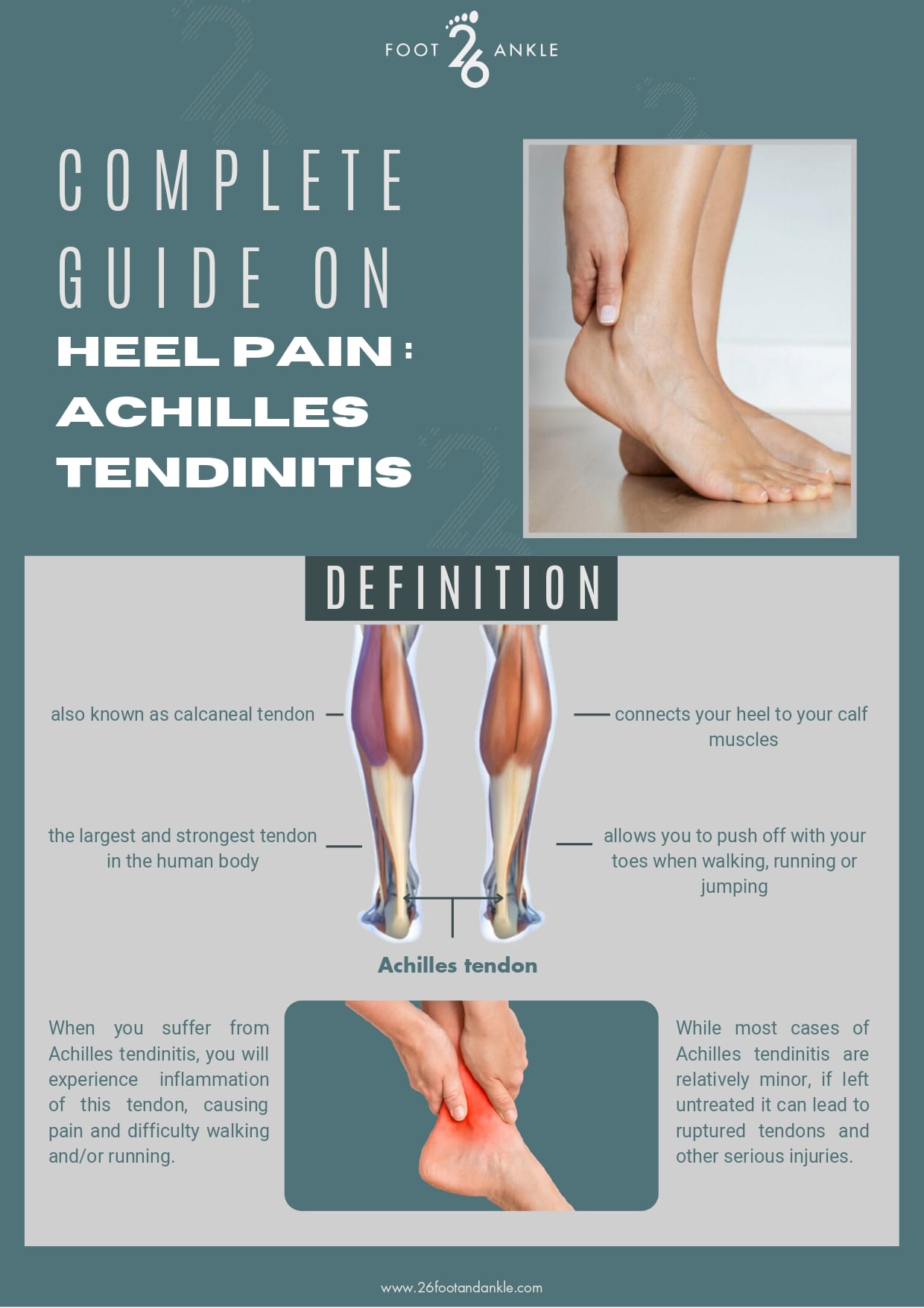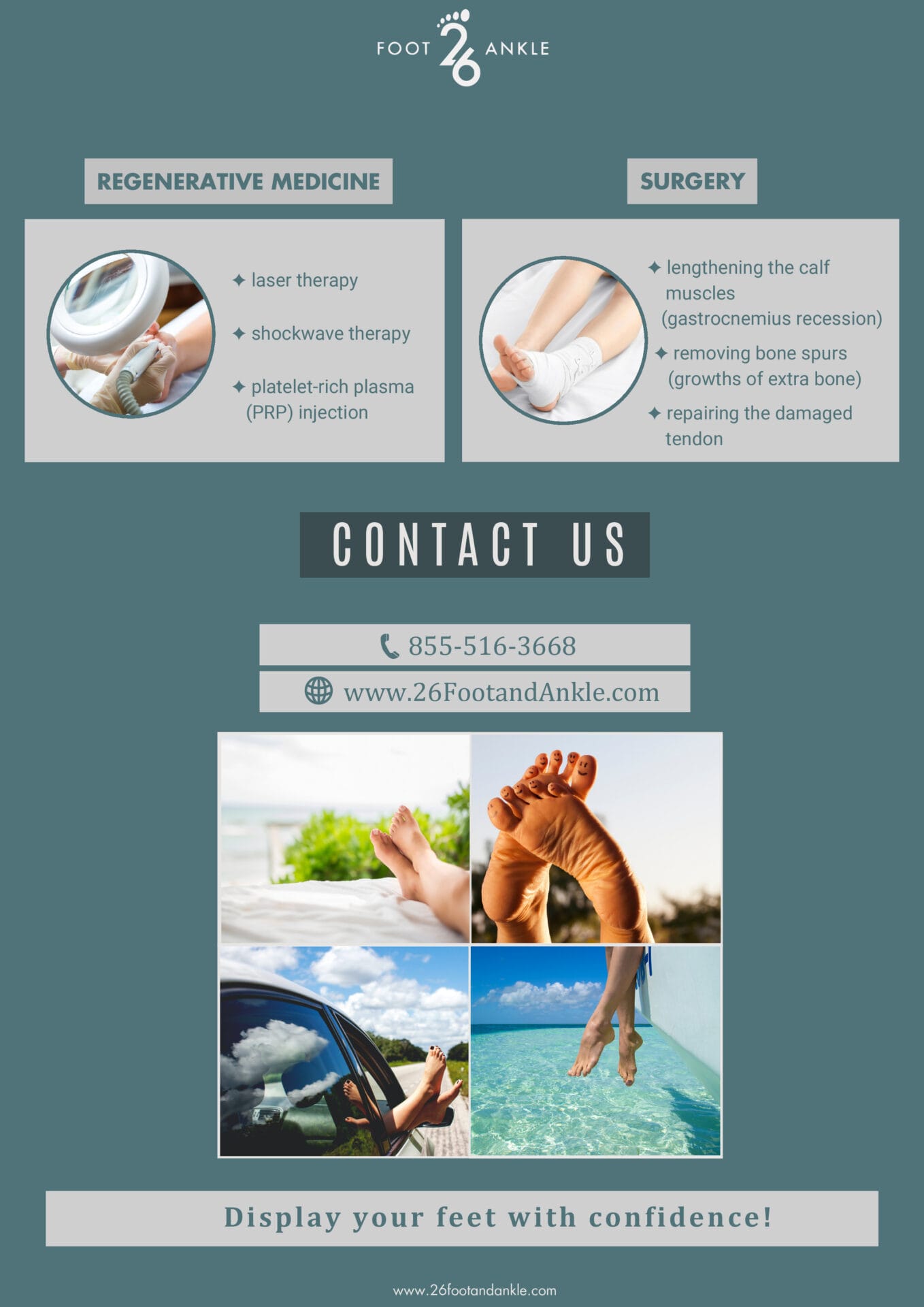The 26 Review
- What is Achilles Tendinitis an overuse injury including inflammation, pain, and in severe cases tears or ruptures
- Causes repetitive or intense strain on the Achilles tendon, trauma, oral antibiotics
- Symptoms pain in back of the heel and/or Achilles tendon, stiffness, swelling, warmth, difficulty walking
- Diagnosis physical examination, ultrasound, X-Ray, and MRI
- Treatment rest, ice, anti-inflammatory medications, taping, bracing, walking boot, physical therapy, surgery
Heel Pain: Achilles Tendinitis E-Book


ACHILLES TENDINITIS
Unleash the power of pain-free mobility! Our ebook is your ultimate guide in conquering Achilles tendinitis. Dive into a wealth of insights, expert advice, and actionable steps to overcome discomfort and rediscover your agility. Don’t let Achilles tendinitis hold you back download now and stride confidently towards a lifestyle of strength and flexibility!

Let’s take a closer look…
The Achilles tendon, otherwise known as the calcaneal tendon, is the largest and strongest tendon in the human body. It connects your heel to your calf muscles, allowing you to push off with your toes when walking, running or jumping. When you suffer from Achilles tendinitis, you will experience inflammation of this tendon, causing pain and difficulty walking and/or running. While most cases of Achilles tendinitis are relatively minor, if left untreated it can lead to ruptured tendons and other serious injuries.
Causes
There are many different things that can contribute to Achilles tendinitis since our Achilles is activated by almost every activity that we perform with our feet, ankles or legs. When walking, running, and jumping, the Achilles tendon is put under a lot of stress and strain. Over time, the constant strain can break down the tissue, resulting in pain, stiffness, and swelling. The stress placed on your feet and ankles when you play sports such as running, basketball, or tennis may also contribute to Achilles tendonitis. Occasionally, even walking or stair climbing might cause this injury. Achilles tendonitis can also be caused by shoes that don’t fit well or have worn out heels. Lack of flexibility may also contribute to Achilles tendonitis, so it is very important to have a good stretch routine for your calves, ankles and feet as part of your self-care each day. In rare cases, taking certain medications have been reported to lead to Achilles tendon injuries.
Symptoms
Achilles tendinitis is characterized by pain and swelling in the back of your heel. Your calf muscles may also be tight, and you may have limited range of motion when you flex your foot. The following symptoms are common with Achilles tendinitis and are most widely reported as a result of having this condition: pain in your heel or behind your calf when you touch or move it, pain or swelling that worsens when you’re walking or running, or the day after you’ve exercised, discomfort or swelling in the back of your heel, limited range of motion when flexing your foot, stiffness and soreness in the Achilles tendon especially upon waking up, warmth around the heel or along the tendon, and thickening of the Achilles tendon.
Diagnosis
Your doctor will ask about your symptoms, general health, and medical history, as well as examine your Achilles tendon for bone spurs and swelling. Your doctor might instruct you to stand on the balls of your feet, so that he or she can examine your flexibility and range of motion. The doctor may feel around the area to find where the pain and swelling are the worst. If your doctor suspects you have Achilles tendinitis, they will likely recommend imaging tests. These tests include X-rays to evaluate the back of the heel bone for bone spur formation. An ultrasound of the tendon can evaluate tendon movements, damage, and inflammation, while an MRI is more specific for evaluate the extent of the tissue damage.
Treatment For Achilles Tendinitis
There are several options available for treating Achilles tendinitis ranging from light home remedies to more invasive procedures, including regenerative medicine procedures and surgery. The most important thing is to rest the affected area and avoid activities that aggravate the condition. Other common treatments for Achilles tendinitis include: reducing your physical activity such as switching to low-impact exercises like swimming; gentle stretching; strengthening of your calf muscles; icing the area after exercise or when in pain; elevating your foot to decrease any swelling; wearing an ankle brace or walking boot; physical therapy; using anti-inflammatory medication for pain relief; wearing a shoe with a higher heel or heel lift and getting fitted for custom orthotics to take pressure off the Achilles tendon. Regenerative medicine options such as a platelet-rich plasma (PRP) injection, shockwave therapy, and laser therapy are additional options that can facilitate tissue healing.
In some cases, surgery may be necessary to repair the tendon if at-home treatments are unsuccessful. If you have an Achilles tendon problem, your doctor can recommend a few options based on the severity of your condition and where the damaged tissue is located. Surgery may include lengthening the calf muscles (gastrocnemius recession), removing bone spurs (growths of extra bone), and repairing the damaged tendon.